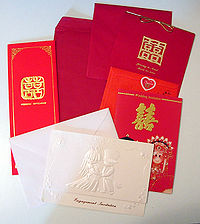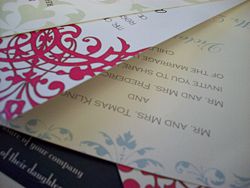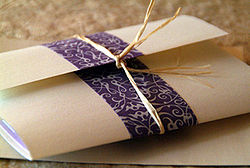
Wedding invitation
Encyclopedia

Wedding
A wedding is the ceremony in which two people are united in marriage or a similar institution. Wedding traditions and customs vary greatly between cultures, ethnic groups, religions, countries, and social classes...
. It is typically written in formal, third-person language and mailed five to eight weeks before the wedding date.
Like any other invitation, it is the privilege and duty of the host—historically, for younger brides in Western culture, the mother of the bride, on behalf of the bride's family—to issue invitations, either by sending them herself or causing them to be sent, either by enlisting the help of relatives, friends, or her social secretary
Secretary
A secretary, or administrative assistant, is a person whose work consists of supporting management, including executives, using a variety of project management, communication & organizational skills. These functions may be entirely carried out to assist one other employee or may be for the benefit...
to select the guest list and address envelopes, or by hiring a service. With computer technology, some are able to print directly on envelopes from a guest list using a mail merge
Mail merge
Mail merge is a software function which allows to create multiple documents from a single template form and a structured data source.-History:This technique of merging data to create gave rise to the term mail merge....
with word processing
Word processing
Word processing is the creation of documents using a word processor. It can also refer to advanced shorthand techniques, sometimes used in specialized contexts with a specially modified typewriter.-External links:...
and spreadsheet
Spreadsheet
A spreadsheet is a computer application that simulates a paper accounting worksheet. It displays multiple cells usually in a two-dimensional matrix or grid consisting of rows and columns. Each cell contains alphanumeric text, numeric values or formulas...
software.
Text
Etiquette regarding the text on a formal wedding invitation varies according to country, culture and language. In Western countries, a formal invitation is typically written in formal, third-person language, saying that the hostHospitality
Hospitality is the relationship between guest and host, or the act or practice of being hospitable. Specifically, this includes the reception and entertainment of guests, visitors, or strangers, resorts, membership clubs, conventions, attractions, special events, and other services for travelers...
s wish for the recipient to attend the wedding and giving its date, time, and place.
As the bride's parents are traditionally the hosts of the wedding, the text commonly begins with the names of the bride's parents as they use them in formal social contexts, e.g., "Mr. and Mrs. John Q Smith" or "Dr. Mary Jones and Mr. John Smith". The exact wording varies, but a typical phrasing runs as follows:

Dr. Mary Jones and Mr. John Smith
request the honour of your presence
at the wedding of their daughter
Mary Jane
to
Colonel Dusty Rhodes
at two o'clock
on the first of November
at Christchurch Hall
Note the seemingly anglicised spelling 'honour'; this derives from a ruling laid down by Emily Post
Emily Post
Emily Post was an American author famous for writing on etiquette.-Background:Post was born as Emily Price in Baltimore, Maryland, into privilege as the only daughter of architect Bruce Price and his wife Josephine Lee Price of Wilkes-Barre, Pennsylvania...
in the 1920s. Other words formed in the same way, such as 'favor', are not similarly modified but retain their U.S. spelling.
In the United Kingdom
United Kingdom
The United Kingdom of Great Britain and Northern IrelandIn the United Kingdom and Dependencies, other languages have been officially recognised as legitimate autochthonous languages under the European Charter for Regional or Minority Languages...
, the line "request...presence" is more usually rendered as "request the pleasure of your company". Another common British practice is to make provision for inserting the names[s] of the guest or guests by using some such form as "request the pleasure of the company of ........ ", the dots representing a separate dotted line on which the name or names can be inserted by hand. Another difference between British and U.S.conventions is that in Britain the date is usually written in a mixture of words and figures rather than in words alone (e.g. "on Tuesday 1st November 2011").
If the groom's parents are also hosts of the wedding, then their names may be added as well. If the parents are not the hosts of the wedding, then the host's name is substituted in the first line, or, especially if the bride and groom are themselves the hosts, it may be written in the passive voice: "The honour of your presence is requested at the wedding of..."
Formal announcements, sent after the wedding ceremony, omit the time and sometimes the place, but usually retain the same general form.
Informal invitations, appropriate to less formal weddings, are issued by word of mouth or by hand-written letter. So long as they convey the necessary practical information about the time and place, there is no set form for these invitations.
Printing and design

Engraving
Engraving is the practice of incising a design on to a hard, usually flat surface, by cutting grooves into it. The result may be a decorated object in itself, as when silver, gold, steel, or glass are engraved, or may provide an intaglio printing plate, of copper or another metal, for printing...
, lithography
Lithography
Lithography is a method for printing using a stone or a metal plate with a completely smooth surface...
, thermography
Thermography
Infrared thermography, thermal imaging, and thermal video are examples of infrared imaging science. Thermal imaging cameras detect radiation in the infrared range of the electromagnetic spectrum and produce images of that radiation, called thermograms...
, letterpress printing
Letterpress printing
Letterpress printing is relief printing of text and image using a press with a "type-high bed" printing press and movable type, in which a reversed, raised surface is inked and then pressed into a sheet of paper to obtain a positive right-reading image...
, sometimes blind embossing, compression plate process, or offset printing
Offset printing
Offset printing is a commonly used printing technique in which the inked image is transferred from a plate to a rubber blanket, then to the printing surface...
. More recently, many do-it-yourself brides are printing on their home computers using a laser printer
Laser printer
A laser printer is a common type of computer printer that rapidly produces high quality text and graphics on plain paper. As with digital photocopiers and multifunction printers , laser printers employ a xerographic printing process, but differ from analog photocopiers in that the image is produced...
or inkjet printer
Inkjet printer
An inkjet printer is a type of computer printer that creates a digital image by propelling droplets of ink onto paper. Inkjet printers are the most commonly used type of printer and range from small inexpensive consumer models to very large professional machines that can cost up to thousands of...
. For the artistically inclined, they can be handmade or written in calligraphy
Calligraphy
Calligraphy is a type of visual art. It is often called the art of fancy lettering . A contemporary definition of calligraphic practice is "the art of giving form to signs in an expressive, harmonious and skillful manner"...
.
Historically, wedding invitations were hand-written unless the length of the guest list made this impractical. When mass-production was necessary, engraving was preferred over the only other widely available then option, which was a relatively poor quality of letterpress printing. Hand-written invitations, in the hosts' own handwriting, are still considered most correct whenever feasible; these invitations follow the same formal third-person form as printed ones for formal weddings, and take the form of a personal letter for less formal weddings.
Tissues are often provided by manufacturers to place over the printed text. Originally, the purpose of the tissue was to reduce smudging or blotting, especially on invitations poorly printed or hastily mailed before the ink was fully dried, but improved printing techniques mean they are now simply decorative. Those who know that their original purpose has been made irrelevant by dramatic improvements in printing technology usually discard them.
Modern invitation design follows fashion trends. Invitations are generally chosen to match the couple's personal preferences, the level of formality of the event, and any color scheme or planned theme. For example, a casual beach wedding may have light, fresh colors and beach-related graphics. A formal church wedding may have more scripty typefaces and lots of ornamentation that matches the formal nature of the event. The design of the invitation is becoming less and less traditional and more reflective of the couple's personality.
The invitation is typically a note card, folded in half, or perhaps French folded (folded twice, into quarters). Other options include a sheet of paper, a tri-fold, or a trendy pocket-fold design. The appropriate paper density depends on the design, but typically ranges from heavy paper to very stiff card stock.
Mailing
Traditionally, wedding invitations are mailed in double envelopes. The inner envelopeEnvelope
An envelope is a common packaging item, usually made of thin flat material. It is designed to contain a flat object, such as a letter or card....
may be lined, is not gummed, and fits into the outer envelope. The outer envelope is gummed for sealing and addressing. More recently, the inner envelope is often left out in the interest of saving money, paper, and postage. In some cases, a pocketfold takes the place of an inner envelope.
In countries that issue them, the envelope may be franked
Franking
Franking are any and all devices or markings such as postage stamps , printed or stamped impressions, codings, labels, manuscript writings , and/or any other authorized form of markings affixed or applied to mails to qualify them to be postally serviced.-Franking types and...
with love stamps. The United States postal service
United States Postal Service
The United States Postal Service is an independent agency of the United States government responsible for providing postal service in the United States...
issues a love stamp each year specifically denominated to cover the double weight of the invitation and reply (a rate slightly less than the cost of two regular stamps).
Other items
In addition to the invitation itself, sellers promote a full panoply of optional printed materials. The ensemble may include an R.S.V.P. response card, a separate invitation to a wedding receptionWedding reception
A wedding reception is a party held after the completion of a marriage ceremony. It is held usually as hospitality for those who have attended the wedding, hence the name reception: the couple receives society, in the form of family and friends, for the first time as a married couple. Hosts...
, and information such as maps, directions, childcare options, and hotel accommodations.
These printers also sell matching pieces intended for the day of the wedding, such as programs, menus, table cards, place cards as well as wedding favors and party favors such as napkins, coasters, cocktail stirrers and matchboxes.
Response
As with any invitation, the sole obligation of the person receiving it is to respond, as promptly as reasonably possible, to let the hosts know whether or not he will be able to attend. Receiving a wedding invitation does not obligate the recipient either to attend the wedding or to send a gift.A proper response is written on the recipient's normal stationery
Stationery
Stationery has historically meant a wide gamut of materials: paper and office supplies, writing implements, greeting cards, glue, pencil case etc.-History of stationery:...
, following the form of the invitation. For example, if the invitation uses formal, third-person language, then the recipient replies in formal, third-person language, saying either "Mr. Robert Jones accepts with pleasure the kind invitation to the wedding on the first of November", or "Ms. Susan Brown regrets that she is unable to attend the wedding on the first of November."
Pre-printed, pre-addressed, pre-stamped response cards are frequently sent in the hope of encouraging a greater proportion of invited people to respond to the invitation. Some American etiquette experts consider the practice incorrect and ineffective at increasing response rates.
In pop culture
In "The InvitationsThe Invitations (Seinfeld episode)
"The Invitations" is the 24th and final episode of the seventh season of Seinfeld and the 134th overall episode. It originally aired on May 16, 1996. It is notable as being the last episode written by co-creator Larry David before he left the series at the end of this season. He did return,...
" episode of Seinfeld
Seinfeld
Seinfeld is an American television sitcom that originally aired on NBC from July 5, 1989, to May 14, 1998, lasting nine seasons, and is now in syndication. It was created by Larry David and Jerry Seinfeld, the latter starring as a fictionalized version of himself...
, George Costanza
George Costanza
George Louis Costanza is a character in the American television sitcom Seinfeld , played by Jason Alexander. He has variously been described as a "short, stocky, slow-witted, bald man" , "Lord of the Idiots" , and as "the greatest sitcom character of all time"...
's fiancé Susan is killed by licking toxic wedding invitations that George picked out since they were inexpensive.
See also
- Personal wedding websitePersonal wedding websitePersonal Wedding Websites are tradition in which engaged couples employ the use of a website to aid in planning and communication for their wedding. Each wedding website is different and as unique features, a couple has to pick what is best for them. The websites can be free but sometimes can come...
- History of wedding invitationsHistory of wedding invitationsThis article presents a brief history of wedding invitations.-The middle ages and before:Prior to the invention of the Printing press by Johannes Gutenberg in 1447, weddings in England were typically announced by means of a Town crier: a gentleman who would walk through the streets announcing in a...
- MonogramMonogramA monogram is a motif made by overlapping or combining two or more letters or other graphemes to form one symbol. Monograms are often made by combining the initials of an individual or a company, used as recognizable symbols or logos. A series of uncombined initials is properly referred to as a...
- Wedding crashingWedding crashingWedding crashing is the act of coming to a wedding without an invitation.-In real life:Some of the most common reasons for crashing a wedding in real life are:...

